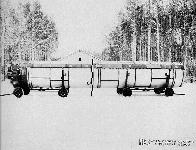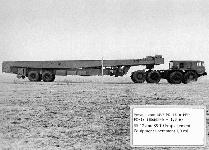





The UR-100MR / SS-17 intercontinental ballistic missile is a two-stage, tandem, storable liquid-propellant missile intended to replace the light UR-100 SS-11 missile. It was a competing design with the SS-19 Stiletto, though in fact both were deployed. It was the first Soviet ICBM to have a Multiple Independently targetable Reentry Vehicle (MIRV) and the first to use a cold launch system. The UR-100MR / SS-17 intercontinental ballistic missile was assessed as being capable of delivering a throw-weight of 6,000 lb to a range of 5,500 nm. The throw-weight consists of a post-boost vehicle and either one or four reentry vehicles.
The overall dimensions of the SS-17 were determined by the characteristics of the SS-11 UR-100 silos in which the UR-100MR missile was planned for deployment. The diameter of both stages was increased in relative to that of the UR-100, and is 2.25 m for the first and 2.1m for the second stage. The UR-100MR uses asymmetrical dimethylhydrazine and nitrogen tetraoxide propellants. The first stage uses a closed-cycle single-chambered sustainer engine and a four-chambered open-cycle control motor. The second stage is equipped with a single-chamber open-cycle sustainer, placed inside the lower part of the fuel tank. The flight control during the first stage uses deflecting the control motor chambers, while the second stage uses gas injected into the diverging part of the nozzles. Solid propellant retrorockets are used to separate the stages.
The rocket MR UR-100 was placed in previously hardened SS-11 UR-100 silos. The missiles in their transport-launch canister were inserted into the silo with the use of two shock-absorption belts. The SS-17 uses a sabot cold launch or pop-up launch system that facilitated modifying existing SS-11 facilities.
Specifications | ||||||
|
Mod-1 |
Mod-2 |
Mod-3 |
||||
|
DIA |
SS-17 |
SS-17 |
SS-17 |
|||
|
NATO |
Spanker |
Spanker |
Spanker |
|||
|
Bilateral |
RS-16A |
RS-16A |
RS-16B |
|||
|
Service |
MR-UR-100 |
MR-UR-100 |
MR-UR-100 UTTKh or MR-UR-100U |
|||
|
OKB/Industry |
15A15 |
15A15 |
15A16 |
|||
|
Design Bureau |
OKB-586 Acad. V. F. Utkin |
OKB-586 Acad. V. F. Utkin |
OKB-586 Acad. V. F. Utkin |
|||
|
Approved |
9/1970 |
9/1969 |
8/16/1976 |
|||
|
Years of R&D |
1964-70 |
1964-70 |
||||
|
Engineering and Testing |
1971-74 |
1970-75 |
1977-79 |
|||
|
First Flight Test |
09/15/1972 failure 12/26/71 success |
12/26/1971 |
10/25/1977 |
|||
|
IOC |
05/06/1975 |
1975 |
10/17/1978 |
|||
|
Deployment Date |
12/30/1975 |
12/30/1975 |
12/17/1980 |
|||
|
Type of Warhead |
MIRV |
Single |
MIRV |
|||
|
Warheads |
4 |
1 |
4 |
|||
|
Yield (Mt) |
0.350-0.750 |
3.5-6.0 |
0.550 - 0.750 |
|||
|
Payload (t) |
2.550 |
2.550 |
2.550 |
|||
|
Total length (m) |
22.52 |
21.6 ? 22.52 |
23.9 |
|||
|
Total length w/o Warhead (m) |
20.9 |
20.9 |
20.9 |
|||
|
Missile Diameter (m) |
2.25 |
2.25 |
2.25 |
|||
|
Launch Weight (t) |
71.1 |
71.1 |
71.1 - 72 |
|||
|
Fuel Weight (t) |
63.2 |
63.2 |
63.2 |
|||
|
Range (km) |
10,200 -10,320 |
10,100 -10,320 |
10,200 -11,000 |
|||
|
CEP (m)
|
1,080 |
1,080 |
920 |
|||
|
CEP (m)
|
440-500 |
420-450 |
220-400 |
|||
|
Number of Stages |
2 |
|
Canister length (m) |
21.6 |
|
Canister length w/o Front meters (m) |
|
|
Canister diameter (m) |
2.5 |
|
Booster guidance system |
Inertial, autonomous |
|
1st stage |
2nd stage |
|
|
Length (m) |
14.3, 14.9 |
3.2 |
|
Body diameter (m) |
2.25 |
2.15 |
|
Fueled weight (t) |
59.0 |
|
|
Dry weight (t) |
||
|
Engine Designation |
RD-268 Main Engine |
RD-262 (15D169) |
|
Engine Designation |
RD-263 Vernier Engine |
N/A |
|
Design Bureau |
Acad. V. P. Glushko (OKB-456) |
Yuzhnoye (OKB- 586) |
|
Configuration |
One Main Engine, One Four Chamber Verniers Engine |
One Chamber |
|
Year of R & D main engines |
1969-1973 |
1969-1972 |
|
Year of R & D Vernier engine |
1970-1973 |
N/A |
|
Propellants |
Liquid |
Liquid |
|
Fuel |
UDMH |
UDMH |
|
Oxidizer |
Nitrogen Tetroxide |
Nitrogen Tetroxide |
|
Burning time (sec.) |
130 |
195 |
|
Main Engine Thrust Sea Level/Vacuum (Tonnes) |
117/126 |
14.5 44 Vacuum |
|
Verniers Thrust Sea Level/Vacuum (Tonnes) |
28.230 /? |
N/A |
|
Main Engine Specific Impulse Sea Level/Vacuum (sec.) |
?/319 |
331 Vacuum |
|
Vernier engine Specific Impulse Sea Level/Vacuum (sec.) |
259/301 |
N/A |
|
Basing Mode |
Silo |
|
Hardness |
|
|
Launching Technique |
Mortar Launch |
|
Deployed boosters |
|
|
Test Boosters |
|
|
Warheads Deployed |
|
|
Training Launchers |
|
|
Space Booster Variant |
No |
Deployment Sites
|
START |
Locale US-Designation |
|
Kostroma |
Kostroma |
|
Vypolzovo |
Yedrovo |

 |
 Missile |
 SS-17/RS-16 Stage 1 |
 |
